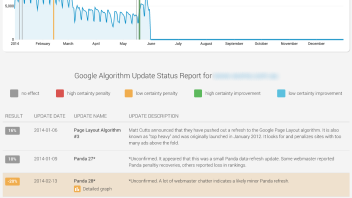This is going to be a quick post about the Google Panda algorithm update. The latest version of the algorithm (4.0) has just rolled out and reports of penalties and recoveries are all over the internet. I present what a recovery looks like through our Google Algorithm Update Checker tool and I speculate a bit on how one can easily spot a Google Panda penalty even though it’s now claimed to be a part of the core-algorithm and no longer an update/data-refresh that runs on certain dates.
The Case
The site in question is a new client of ours and will remain undisclosed for obvious reasons. The site is quite big (# of pages) and has lots of user generated content and had been penalized by a previous Panda data refresh (by our estimates, see more on this bellow). Now that these are coming out irregularly it’s harder to pinpoint them, but the strong recovery certainly helps tell what happened previously.
Panda Penalty & Recovery Analysis
(click the image for a full-size version)
The above is the output of our Google Algorithm Update Checker. It does complex automated analysis of Google traffic patterns and tells you whether your site was hit by a known update or not. In this case it tells us two things:
1. A medium likelihood of the site being a victim of Panda 28 (Feb 13, 2014). The tool is not completely certain about it, but indicates a possibility.
2. Strong likelihood that the site recovered from a Panda penalty during the latest major update of that algorithm.
You may notice how the PaydayLoan update is nicely filtered out as a possible cause, even though it was just a few days prior to the Panda one. We see a 49% uplift in Google traffic following May 19-th with a 98% percent likelihood that this is indeed the effect of a Google algorithm update (this number is not visible on the graph, but is available on hover in the tool).
Looking further into the graph we see a strong drop beginning March 6-th. No known updates or even webmaster chatter is recorded around that date, so it’s hard to tell what was it by looking simply at that event. However, the strong recovery during Panda 4.0 and the traffic levels after the recovery perfectly correspond to the levels before March 6-th. This means that its almost certain that the site was hit by an unregistered Panda data refresh on that date.
Spotting Panda Penalties post 2013
While Matt Cutts claimed in March 2013 that Panda became a part of the core Google algorithm, my understanding is that the Panda algorithm is too complex to be an integral part of the core algorithm. Based on graphs similar to the above which show sharp drops on certain dates I believe it to be core-like, but not a part of the core.
While it executes on certain dates for 100% of the index no more, it really isn’t integrated into the core. Rather, it now executes every several days (a week, 10 days maybe) and covers only a part of the index. Then in another 7-10 days it covers another part of the index. However, the result is the same – a sharp drop in traffic which wouldn’t be seen if Panda was really a part of the ongoing algorithmic evaluation of your site and pages.
This makes it easier to estimate if you are a victim of the cuddly bear or not. You need to do analysis (easier with the above tool) to see if any other known updates have had an impact on your site. If they didn’t and you see a sharp drop in traffic across the board, then you are likely looking at a Panda penalty. This presumes, of course, that you’ve ruled out purely technical issues and recent changes to the site as possible causes.
Notes on Update Dates
While Matt Cutts says Panda 4.0 began on May 20, 2014, we have evidence (such as the above traffic pattern) which points strongly to the update being launched about a day earlier. Moz and other sources confirm this as well which is why the date of the update is May 19-th, not May 20-th.
More on Panda:
Panda Filter hits Ask.com, Ebay.com and Google-backed RetailMeNot
Press Release sites got hit hard by Google’s Panda Update



